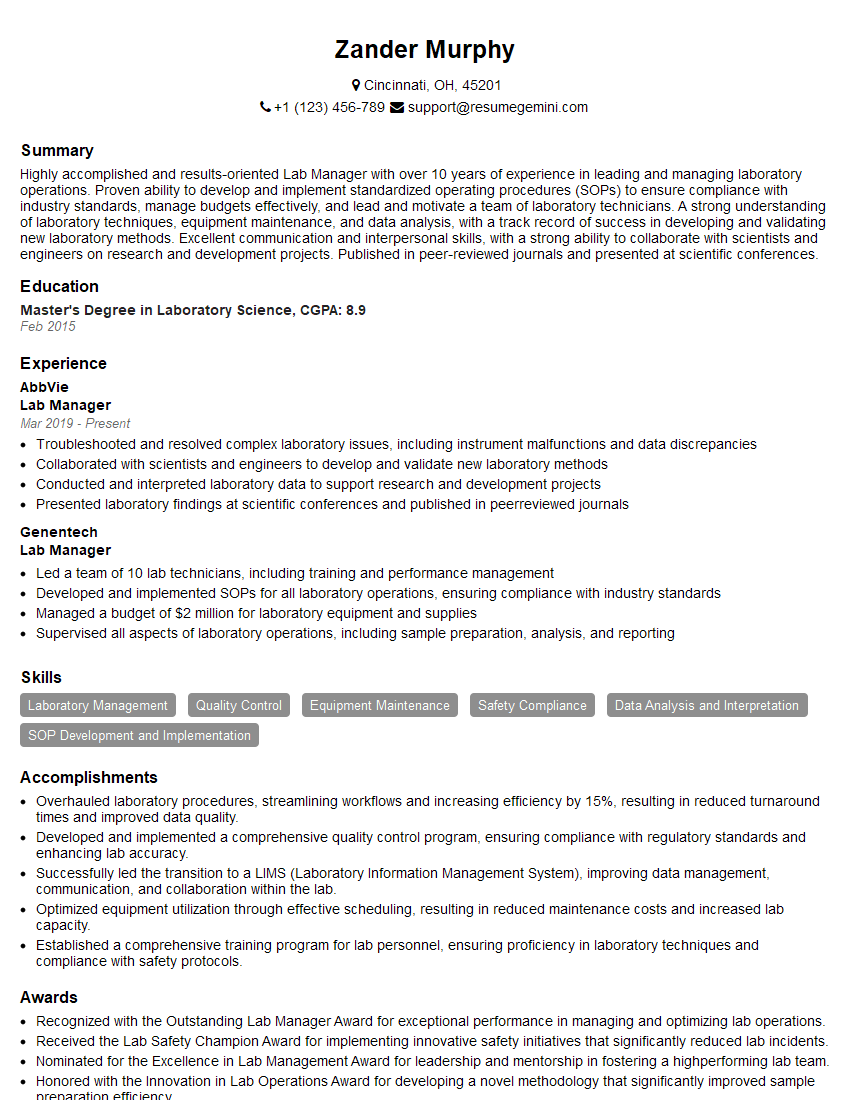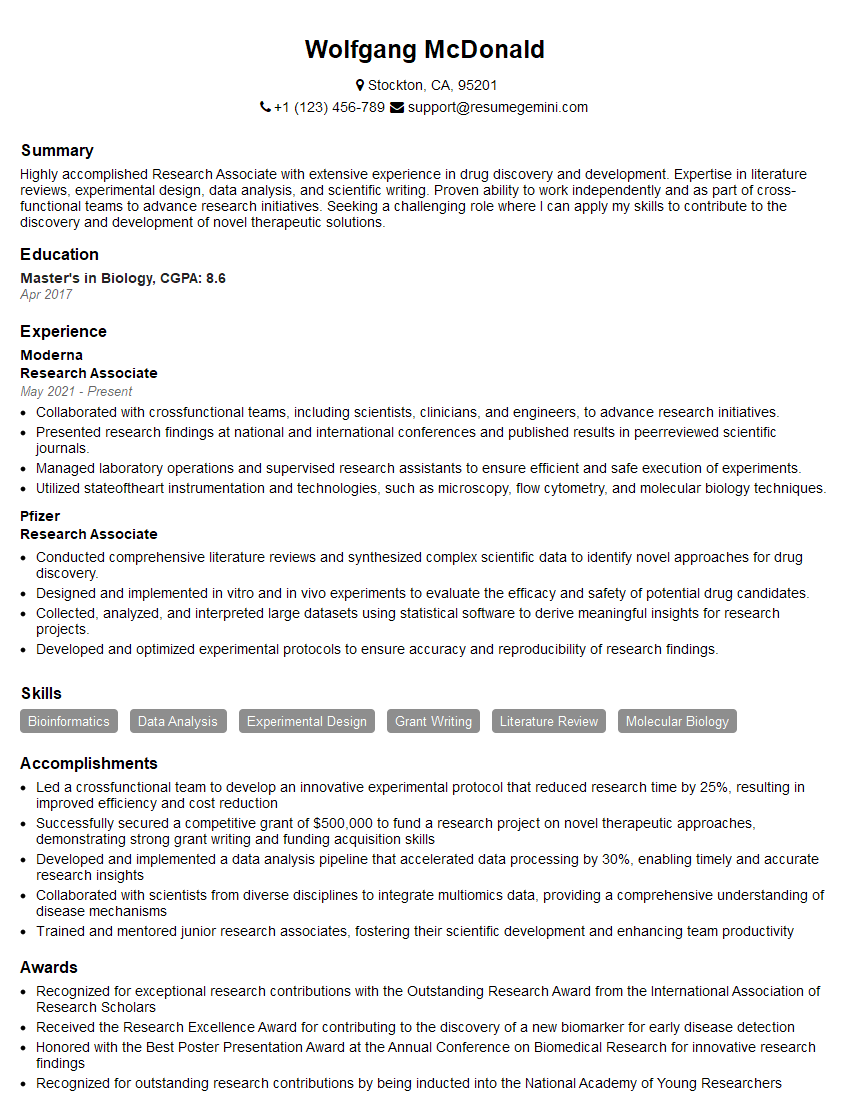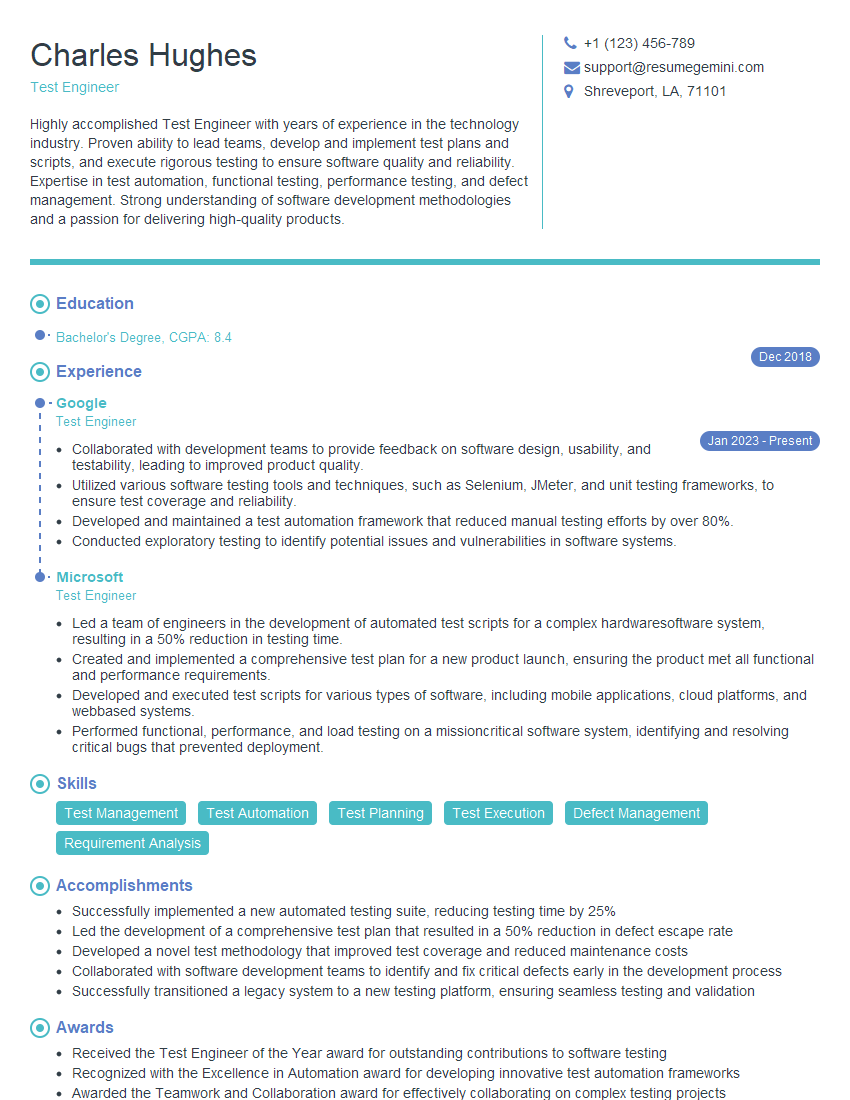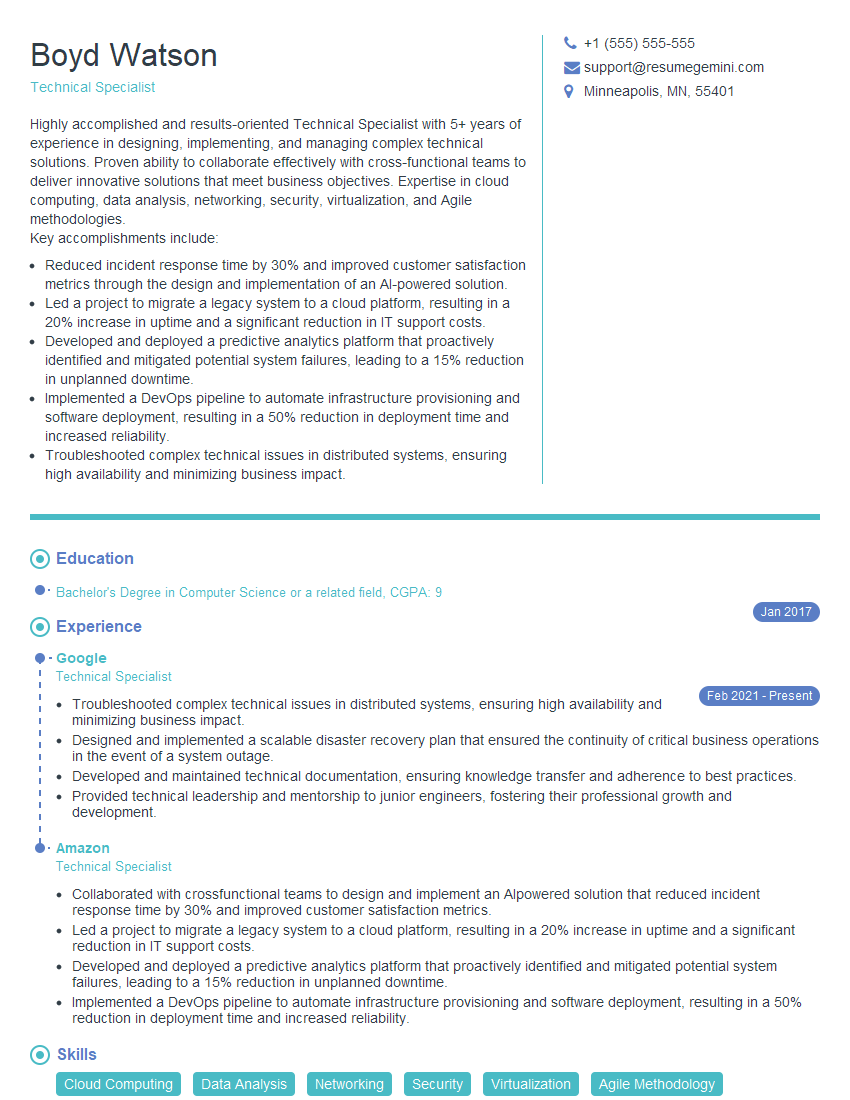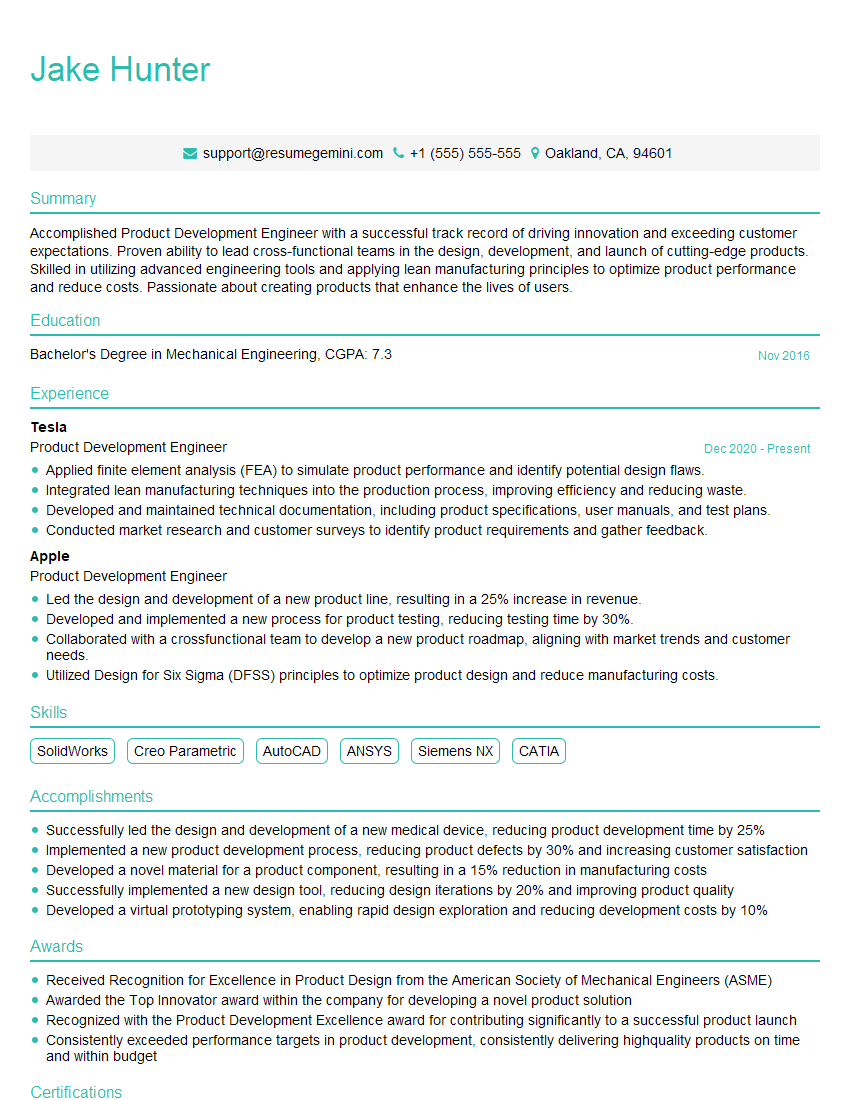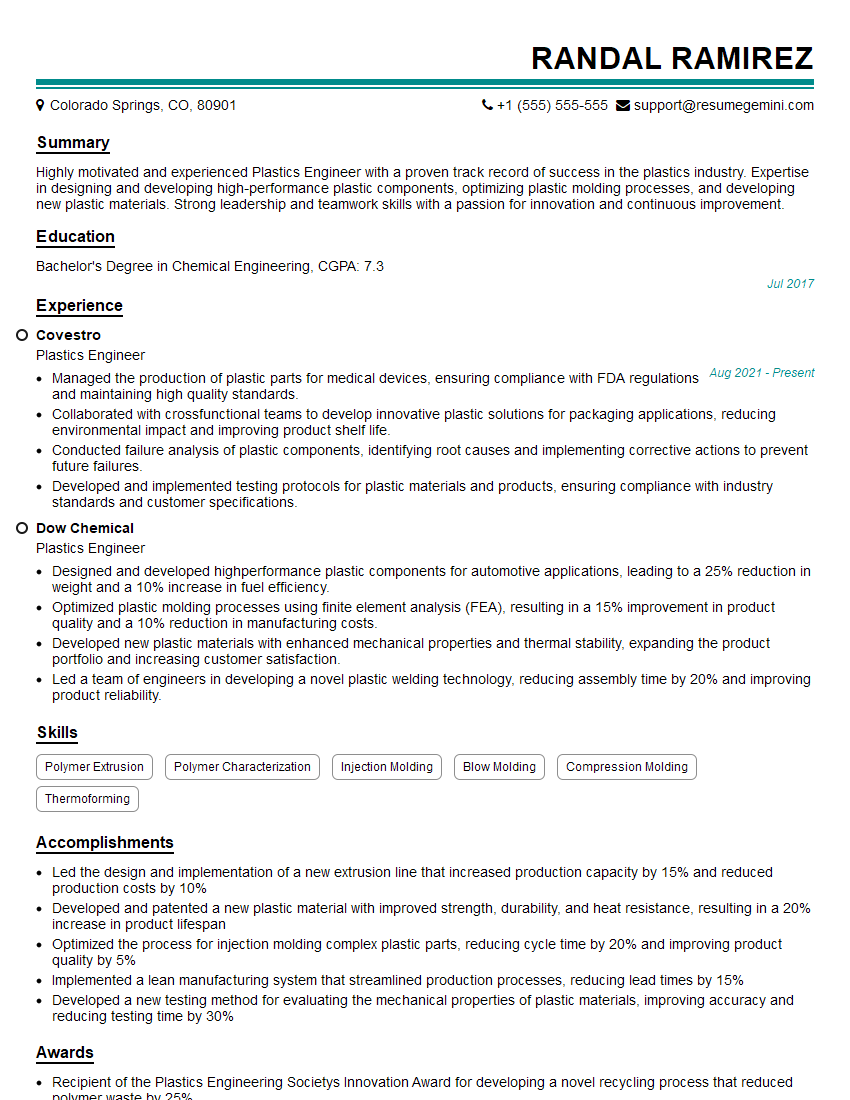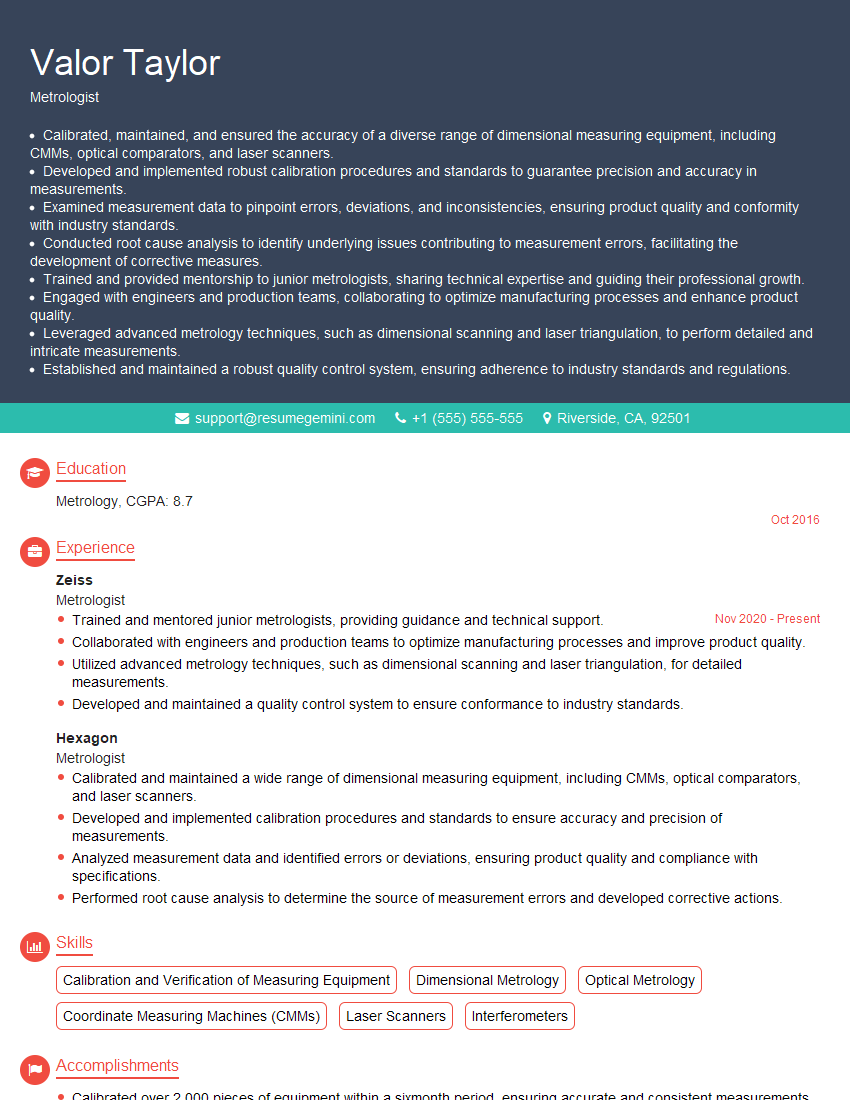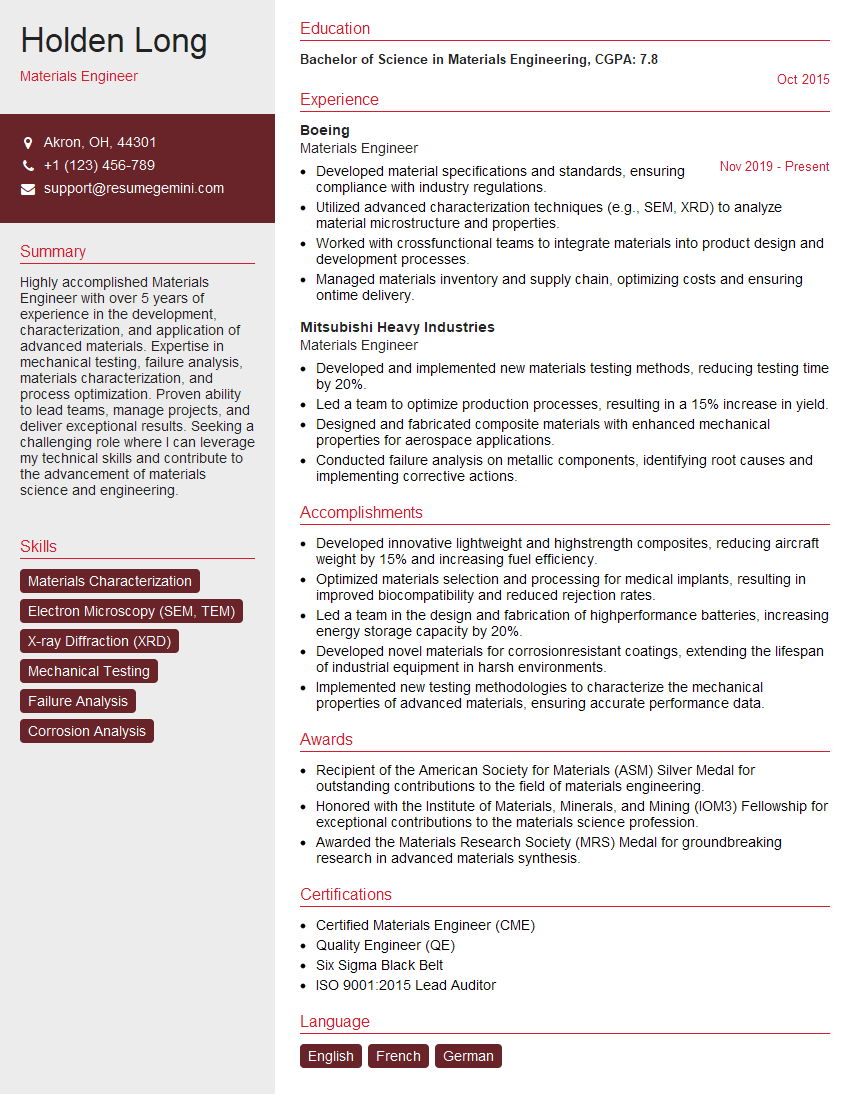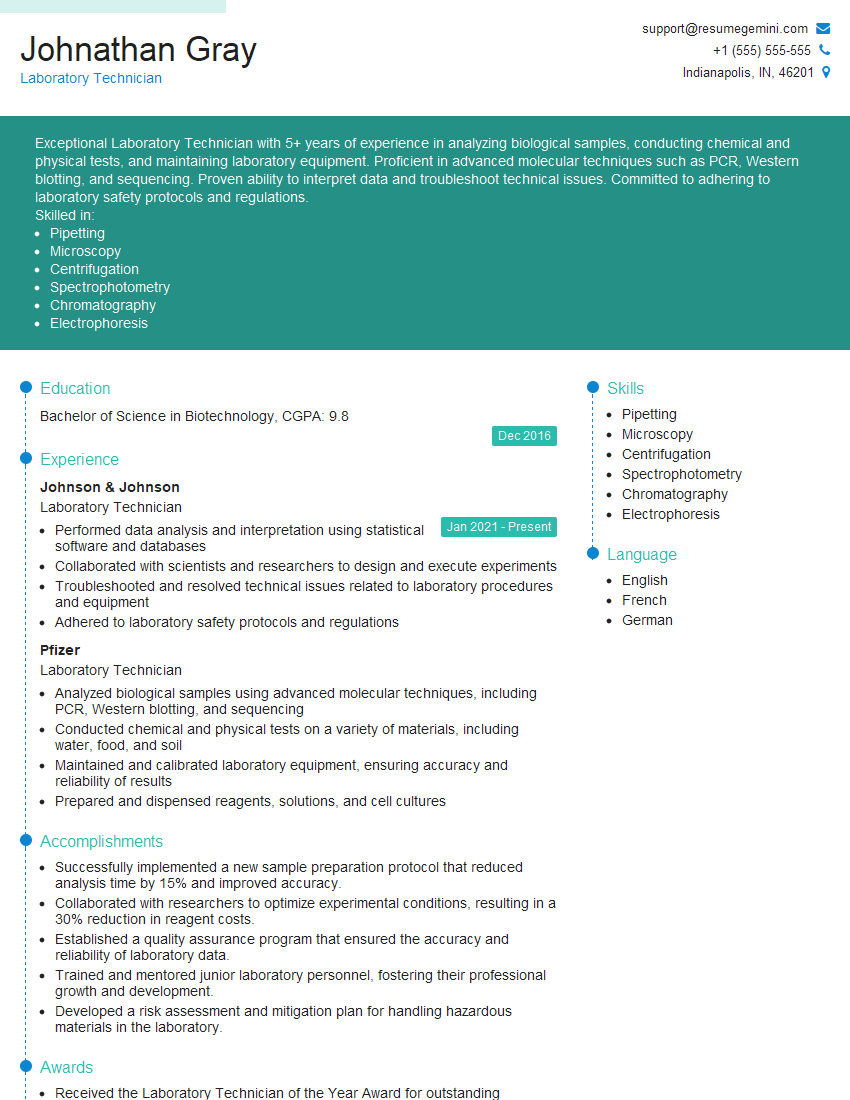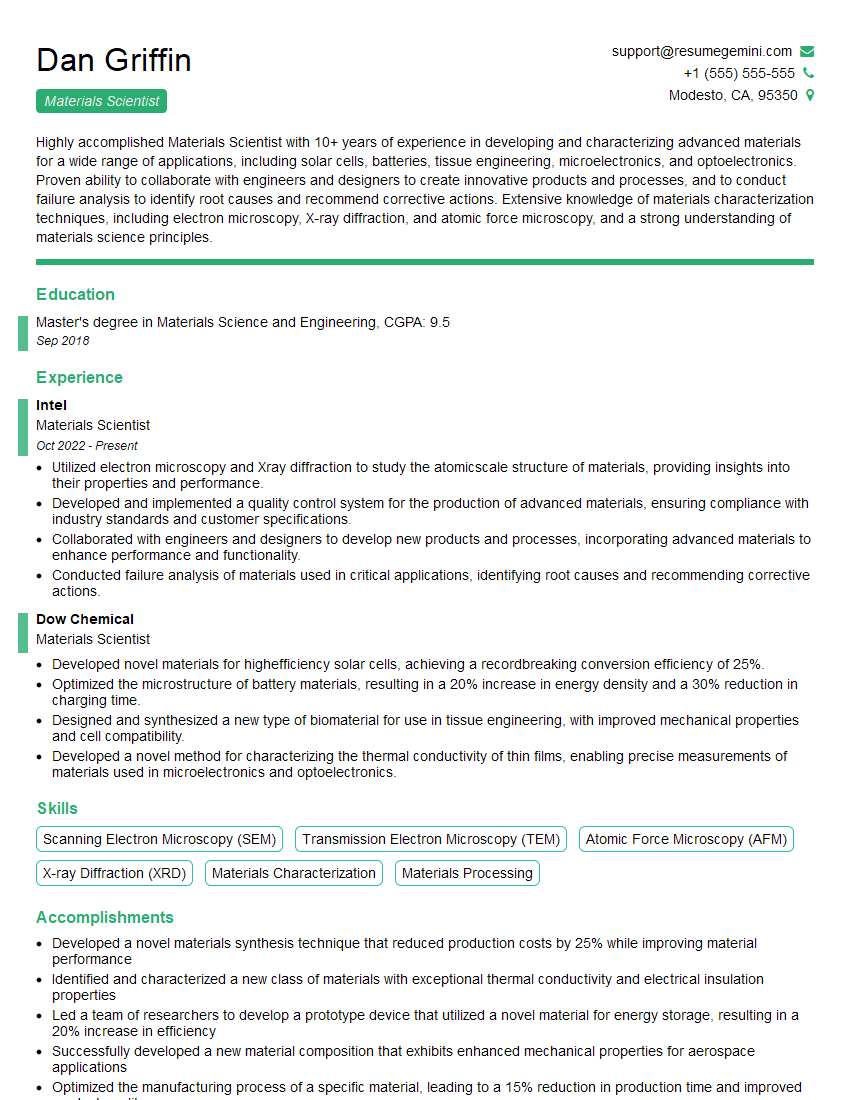Cracking a skill-specific interview, like one for ASTM D882, requires understanding the nuances of the role. In this blog, we present the questions you’re most likely to encounter, along with insights into how to answer them effectively. Let’s ensure you’re ready to make a strong impression.
Questions Asked in ASTM D882 Interview
Q 1. Define ASTM D882 and its significance in materials testing.
ASTM D882 is a standard test method developed by ASTM International (formerly the American Society for Testing and Materials) that outlines the procedures for determining the tensile properties of thin plastic sheeting and films. Its significance lies in providing a standardized and reliable method for evaluating the strength, stiffness, and elasticity of these materials. This is crucial for quality control, material selection, and product design across various industries, including packaging, automotive, and medical devices, where the performance of the plastic film is paramount.
Q 2. Explain the principle of tensile testing as per ASTM D882.
The principle of tensile testing in ASTM D882 involves applying a controlled tensile force to a standardized specimen of plastic film until it breaks. The test measures the material’s response to this force, specifically its ability to withstand tension before failure. The force is applied gradually and uniformly, usually at a constant rate of elongation or crosshead speed. Think of it like carefully pulling apart a piece of tape until it snaps – we are measuring how much force it takes and how much it stretches before breaking.
Q 3. Describe the different types of specimens used in ASTM D882 testing.
ASTM D882 allows for different specimen types, chosen based on the material’s thickness and properties. Common types include:
- Type I: A dumbbell-shaped specimen with a narrow central section that is the primary area under tension. This is commonly used for thicker films.
- Type II: A rectangular specimen with a defined width and gauge length. This is preferred for thinner films.
- Type III: A specimen that is usually a square or rectangular film piece that is clamped directly without a reduced central section. This is suitable for very thin and delicate films to minimize damage during specimen preparation.
The specific dimensions of each type are meticulously defined within the standard to ensure consistent and comparable results. The selection of the appropriate specimen type is critical to obtaining accurate and reliable test data.
Q 4. What are the critical parameters measured in an ASTM D882 test?
The critical parameters measured in an ASTM D882 test include:
- Tensile Strength: The maximum tensile stress (force per unit area) a material can withstand before breaking. This represents its ultimate strength.
- Yield Strength (optional): The stress at which the material begins to deform plastically (permanently). This is not always easy to determine precisely for plastic films.
- Elongation at Break: The percentage increase in length of the specimen at the moment of rupture. This shows the material’s ductility or its ability to stretch before failure.
- Modulus of Elasticity (Young’s Modulus): A measure of the material’s stiffness or resistance to deformation under stress. It is calculated from the initial linear portion of the stress-strain curve.
- Stress at Yield (optional): Indicates the stress required to cause permanent deformation. This parameter is only reported if the yield point is clearly defined in the test results.
Q 5. How do you determine tensile strength, elongation at break, and modulus of elasticity from an ASTM D882 test?
These parameters are determined from the stress-strain curve generated during the test. The stress-strain curve is a plot of stress (force/area) versus strain (change in length/original length).
- Tensile Strength: The highest point on the stress-strain curve corresponds to the tensile strength.
- Elongation at Break: This is calculated from the strain value at the point of fracture.
- Modulus of Elasticity: Calculated from the slope of the initial linear portion of the stress-strain curve (the steeper the slope, the stiffer the material).
The testing machine automatically calculates these values, but understanding how they relate to the curve is important for interpreting results and troubleshooting discrepancies.
Q 6. Explain the importance of proper specimen preparation in ASTM D882 testing.
Proper specimen preparation is crucial for accurate and reliable results. Any imperfections or inconsistencies in the specimen can significantly affect the test outcomes. ASTM D882 specifies details on cutting, handling and conditioning of specimens:
- Accurate dimensions: The specimen must be precisely cut to the dimensions specified in the standard to avoid biased results.
- Avoiding damage: Care must be taken to avoid scratches, tears, or other damage during handling and mounting.
- Conditioning: The specimen should be conditioned to a specific temperature and relative humidity before testing to ensure consistent results. This is usually stated in the specific testing requirements.
- Cleanliness: Cleanliness is essential to ensure that contaminants do not influence the results, particularly for lower-strength materials.
Using proper tools and techniques, adhering meticulously to the standard’s instructions for specimen preparation, will minimize errors and allow for better reproducibility of test results.
Q 7. What are the common sources of error in ASTM D882 testing, and how can they be minimized?
Common sources of error in ASTM D882 testing include:
- Improper specimen preparation: Inaccurate dimensions, damage to the specimen, or inadequate conditioning can lead to inaccurate results.
- Misalignment of grips: If the specimen is not properly aligned in the grips, it may lead to uneven stress distribution and premature failure.
- Incorrect testing speed: Testing at too high or low a speed can affect the measured properties, especially the elongation at break.
- Calibration errors: Regular calibration of the testing machine is essential to ensure accurate force and elongation measurements.
- Environmental factors: Temperature and humidity variations can affect the material’s properties, hence the importance of conditioning.
Minimizing these errors requires careful attention to detail throughout the testing process. This includes using properly calibrated equipment, following the standard’s instructions meticulously, and employing experienced technicians for specimen preparation and testing operations.
Q 8. How do you interpret the stress-strain curve obtained from ASTM D882?
The stress-strain curve generated from ASTM D882, the standard test method for tensile properties of plastics, is a visual representation of a material’s response to tensile loading. It plots stress (force per unit area) against strain (elongation per unit length). Interpreting this curve reveals crucial mechanical properties. The initial, relatively linear portion indicates the elastic region, where the material deforms elastically and returns to its original shape upon unloading. The slope of this line represents the Young’s Modulus (or modulus of elasticity), a measure of the material’s stiffness.
As the load increases, the curve deviates from linearity, entering the plastic region where permanent deformation occurs. Key points on this curve include the yield strength (the stress at which significant plastic deformation begins) and the tensile strength (the maximum stress the material can withstand before breaking). The area under the curve represents the material’s toughness, indicating its ability to absorb energy before fracture. The final portion shows the material’s behavior until failure, revealing its ductility (the ability to deform significantly before breaking).
For instance, a steep initial slope suggests a rigid material with a high Young’s modulus, while a long, gradual curve indicates a ductile material that can withstand significant deformation before failure. Analyzing these characteristics allows engineers to select suitable plastics for various applications.
Q 9. Explain the difference between yield strength and tensile strength.
Yield strength and tensile strength are both crucial indicators derived from the stress-strain curve, but they represent different aspects of a material’s behavior under tension.
Yield strength is the stress at which a material begins to deform plastically. Think of it as the point where the material starts to yield permanently, losing its ability to fully recover its original shape once the load is removed. It’s often determined by the 0.2% offset method, drawing a line parallel to the initial elastic region, offset by 0.2% strain, and identifying the intersection with the stress-strain curve.
Tensile strength, on the other hand, is the maximum stress the material can withstand before it breaks. This is the highest point on the stress-strain curve. It represents the material’s ultimate strength under tensile loading.
Imagine a rubber band. The yield strength would be the point where you stretch it so far that it no longer snaps back perfectly to its original shape. The tensile strength would be the point where it finally breaks.
Q 10. How does temperature affect the tensile properties of plastics?
Temperature significantly influences the tensile properties of plastics. Generally, increasing temperature reduces the tensile strength and modulus while increasing ductility and elongation at break. This is because higher temperatures increase the molecular mobility within the polymer, making it easier to deform.
Think of modeling clay: at room temperature, it holds its shape reasonably well. As you heat it, it becomes more pliable and stretches more easily, mirroring the impact of temperature on plastic’s tensile properties. Conversely, reducing the temperature leads to increased stiffness and strength but reduced ductility, making the plastic more brittle and prone to cracking under stress. Therefore, understanding the temperature dependence of a plastic’s tensile properties is crucial for ensuring its performance in different environmental conditions.
Q 11. How does the rate of loading affect the results of an ASTM D882 test?
The rate of loading, or the speed at which the tensile force is applied during the ASTM D882 test, considerably affects the results. Faster loading rates generally lead to higher yield strength and tensile strength values, along with reduced elongation at break. This is because at higher speeds, the polymer chains have less time to rearrange and relax, resulting in a more brittle response.
Conversely, slower loading rates permit more chain mobility, leading to higher elongation before fracture and a more ductile behavior. This phenomenon is known as the strain rate effect and is a critical factor in determining the suitability of a plastic for specific applications. For instance, a plastic designed for impact applications needs to be evaluated at a high strain rate, while a plastic for flexible applications may require testing at a slow rate.
Q 12. Describe the different types of grips used in ASTM D882 testing and their applications.
ASTM D882 allows for various grip types, each suited for specific specimen geometries and material properties. The choice of grip significantly impacts the accuracy and reliability of the test results. Improper gripping can lead to premature failure or inaccurate measurements.
- Wedge grips: These are commonly used for flat specimens and are effective in holding the material securely. However, they can cause stress concentrations at the grip jaws, potentially leading to premature failure of the specimen.
- Pneumatic grips: These offer a more consistent and even clamping force, reducing the risk of stress concentrations. They are suitable for both flat and round specimens.
- Self-tightening grips: As the material stretches, these grips automatically increase their clamping force, ensuring good contact throughout the test.
- Smooth grips: Designed to minimize stress concentrations, they are suitable for materials that are prone to slippage or damage in other grip types. They often require a more meticulous specimen preparation.
The selection of the appropriate grip type depends on the specimen’s shape, material properties, and the desired accuracy of the test. Improper grip selection can lead to unreliable data and incorrect conclusions about the material’s tensile properties.
Q 13. What are the limitations of ASTM D882?
While ASTM D882 is a widely used and valuable standard, it has certain limitations:
- Specimen preparation: The accuracy of the test is highly dependent on the precision of specimen preparation, including dimensions and surface finish. Inconsistent preparation can lead to variability in the results.
- Grip effects: As mentioned earlier, grip selection and application can introduce stress concentrations, leading to premature failure and inaccurate measurements.
- Environmental conditions: Temperature and humidity can significantly affect the results, and controlled conditions are necessary for consistent and reproducible data.
- Material limitations: ASTM D882 is not suitable for all types of plastics. Highly viscous or very brittle materials may pose challenges during testing.
- Rate dependency: The results are strongly dependent on the rate of loading, limiting the applicability of the data to specific loading conditions. It doesn’t always translate well to real-world scenarios with variable loading rates.
It’s crucial to be aware of these limitations when interpreting the results and to ensure appropriate procedures are followed to mitigate the risks associated with them.
Q 14. Explain the significance of the gauge length in ASTM D882 testing.
The gauge length in ASTM D882 testing refers to the length of the specimen between the grips where strain measurements are taken. It’s a critical parameter because it directly affects the calculated strain values. A longer gauge length will yield smaller strain values for the same elongation, while a shorter gauge length will show larger strain values. This is because strain is calculated as the change in length divided by the original length.
The standard specifies recommended gauge lengths depending on the specimen thickness and type of plastic. Choosing the incorrect gauge length can result in inaccurate strain measurements and misinterpretations of the material’s ductility and other properties. Consistent gauge length is necessary for comparing results from different tests, ensuring meaningful data analysis and material comparison.
Q 15. How do you ensure the accuracy and precision of ASTM D882 test results?
Ensuring the accuracy and precision of ASTM D882 test results hinges on meticulous attention to detail throughout the entire testing process. Accuracy refers to how close the measured value is to the true value, while precision refers to how close repeated measurements are to each other. To achieve both, we need a multi-pronged approach.
- Proper Sample Preparation: This is paramount. Samples must be representative of the entire batch, properly conditioned (temperature and humidity controlled according to the standard), and free from any defects that could skew results. Think of it like baking a cake – if your ingredients aren’t measured accurately and your oven isn’t at the right temperature, your cake won’t turn out well.
- Calibration of Equipment: Regular calibration of the tensile testing machine is crucial. This involves using certified standards to verify the machine’s force and elongation measurements are accurate. We typically use traceable standards, linked back to national metrology institutes.
- Following Standard Procedures: Adherence to the specified ASTM D882 test method is non-negotiable. This includes the correct choice of grips, test speed, and specimen dimensions. Deviating from the standard will invalidate the results.
- Statistical Analysis: Multiple specimens should be tested to account for material variability. Statistical methods, such as calculating the average and standard deviation, are used to assess the precision of the results. Outliers, which are discussed in the next question, are carefully considered.
- Environmental Control: The testing environment itself should be controlled to minimize the influence of external factors like temperature and humidity fluctuations on the results.
By carefully managing all these aspects, we can confidently say our ASTM D882 test results are both accurate and precise, providing reliable data for material characterization and quality control.
Career Expert Tips:
- Ace those interviews! Prepare effectively by reviewing the Top 50 Most Common Interview Questions on ResumeGemini.
- Navigate your job search with confidence! Explore a wide range of Career Tips on ResumeGemini. Learn about common challenges and recommendations to overcome them.
- Craft the perfect resume! Master the Art of Resume Writing with ResumeGemini’s guide. Showcase your unique qualifications and achievements effectively.
- Don’t miss out on holiday savings! Build your dream resume with ResumeGemini’s ATS optimized templates.
Q 16. Describe the calibration procedures for the testing equipment used in ASTM D882.
Calibration of the tensile testing machine used in ASTM D882 is a critical step to ensure accurate and reliable results. This is typically done using certified calibration weights and extensometers.
- Force Calibration: Certified weights are applied to the load cell, and the machine’s reading is compared against the known weight. Any discrepancies are adjusted according to the manufacturer’s instructions. Think of it like calibrating a kitchen scale – you use known weights to ensure the scale is accurately measuring.
- Extensometer Calibration: The extensometer, which measures elongation, is also calibrated using a standardized gauge length. This ensures accurate measurement of the specimen’s strain. Again, traceable standards are used for validation.
- Frequency: Calibration should be performed regularly, typically according to a schedule defined by the laboratory’s quality management system and the equipment manufacturer’s recommendations, often annually or semi-annually. This frequency may need to be increased based on usage.
- Documentation: All calibration procedures and results must be meticulously documented and traceable to ensure the validity of the test results.
Failing to properly calibrate the equipment can lead to significant errors in the tensile strength, elongation, and modulus measurements, potentially affecting product quality and safety.
Q 17. How would you handle outliers in your ASTM D882 test data?
Handling outliers in ASTM D882 data requires a careful and systematic approach. Outliers are data points that significantly deviate from the rest of the data set. They can be caused by various factors, including testing errors or material defects.
- Investigation: The first step is to thoroughly investigate the outlier. This involves examining the test procedure, checking for any equipment malfunctions, and inspecting the specimen for flaws. For example, a tear in the specimen could drastically affect the tensile strength.
- Grubbs’ Test: Statistical tests, like Grubbs’ test, can be used to formally determine if an outlier should be rejected. This test helps determine whether a data point is statistically different from the rest of the sample.
- Data Exclusion: If the investigation reveals a clear error, the outlier can be excluded from the final calculations. However, this should be carefully documented, and justification for exclusion should be provided.
- Data Inclusion: If no clear error is identified and the outlier cannot be statistically rejected, it should be included in the analysis, but its effect on the overall results should be considered and reported. This could be done by reporting the mean with and without the outlier, or by using a more robust statistical method less sensitive to outliers.
A common mistake is arbitrarily discarding outliers without proper investigation, which might lead to inaccurate conclusions. Therefore, a thorough investigation is necessary before making any decisions regarding outliers.
Q 18. What are the reporting requirements for ASTM D882 test results?
ASTM D882 reporting requirements are quite specific. The report should clearly identify the tested material, the specific test method used (e.g., D882-19, Method A), the date of testing, the number of specimens tested, and the average, standard deviation, and any other relevant statistical data such as the minimum and maximum values.
- Specimen Identification: Detailed information about the specimens, including their dimensions and identification numbers, is essential.
- Testing Conditions: Environmental conditions (temperature and relative humidity) during the test should be recorded.
- Test Parameters: Test parameters such as the crosshead speed, and the type of grips used should be clearly stated.
- Results: Tensile strength, yield strength (if applicable), elongation at break, and modulus of elasticity (Young’s modulus) should be reported, with appropriate units.
- Compliance: The report should indicate that the testing was conducted according to ASTM D882.
A well-structured report ensures that the results are understandable, unambiguous, and auditable, allowing for comparisons between different tests and batches of materials. Poor reporting can lead to misinterpretations and potentially unsafe use of the material.
Q 19. How do you select the appropriate test method within ASTM D882 based on material type?
ASTM D882 offers different test methods (Methods A, B, C, etc.) depending on the material’s thickness and properties. The choice of the correct method is crucial for obtaining meaningful and reliable results. The standard provides guidance on this selection.
- Method A: This is typically used for thin films, typically less than 1 mm thick. The specimen is gripped over its entire width.
- Method B: This method is generally suitable for thicker materials and uses dumbbell-shaped specimens.
- Method C: This method might be used for materials that are difficult to grip with conventional methods.
The decision on which method to use is based primarily on the specimen thickness. However, additional factors such as the material’s stiffness and the availability of suitable grips might influence this decision. The standard clearly outlines the appropriate method for various material thicknesses; adhering to these guidelines prevents erroneous results.
Incorrect method selection can lead to premature failure, inaccurate stress-strain curves, and unreliable mechanical properties. Imagine trying to use a method designed for a thin film on a thick sheet – the results would be meaningless.
Q 20. Compare and contrast ASTM D882 with other relevant ASTM standards for plastics testing.
ASTM D882 focuses specifically on the tensile properties of plastics. It’s crucial to differentiate it from other standards that test different properties or material types.
- Comparison with ASTM D638: ASTM D638 is another widely used standard for determining the tensile properties of plastics, but it’s often applied to more rigid materials, unlike D882 which has methods for testing thin films. While both methods measure tensile strength, elongation, and modulus, D638 usually uses different specimen geometries and is more frequently applied to thicker, more rigid plastics.
- Comparison with ASTM D790: ASTM D790 covers the flexural properties of plastics, measuring their ability to withstand bending loads. This is a completely different mechanical property compared to the tensile strength measured in D882.
- Comparison with ASTM D256: ASTM D256 determines the notched Izod or Charpy impact resistance of plastics. Impact resistance is a different mechanical property that quantifies a material’s ability to absorb impact energy. It does not measure tensile strength.
Selecting the correct standard is vital. Using D882 to evaluate impact strength, for instance, would be inappropriate and provide misleading results. Each standard addresses specific material properties, and choosing the right one is a cornerstone of accurate material characterization.
Q 21. Explain the concept of Poisson’s ratio and its relevance to ASTM D882.
Poisson’s ratio is a measure of a material’s tendency to deform in one direction when compressed or stretched in a perpendicular direction. While not explicitly calculated in the standard ASTM D882 tensile test, it’s an important material property that is conceptually linked to the test.
In a tensile test, as the material is stretched, it typically contracts in the transverse direction. Poisson’s ratio (ν) quantifies this relationship: ν = – (lateral strain / axial strain). A higher Poisson’s ratio indicates a greater tendency for lateral contraction under axial tension.
Although ASTM D882 doesn’t directly measure Poisson’s ratio, the stress-strain curve obtained from the tensile test can be used to calculate it using strain measurements in both the axial and transverse directions. This requires specialized extensometers capable of measuring both axial and transverse strain.
Understanding Poisson’s ratio is important because it’s a fundamental material property influencing a material’s response to stress and strain, providing insights into its elasticity and overall mechanical behavior beyond simply its tensile strength.
Q 22. How does the crosshead speed affect the results obtained in ASTM D882 testing?
Crosshead speed in ASTM D882, the standard test method for tensile properties of thin plastic sheeting, significantly impacts the results. Think of it like stretching a rubber band: a slow stretch allows the rubber band to yield gradually, while a fast stretch might cause it to snap unexpectedly. Similarly, the speed at which the plastic specimen is elongated affects its tensile strength and elongation at break.
A faster crosshead speed generally leads to higher tensile strength and lower elongation at break. This is because the higher speed doesn’t allow enough time for molecular rearrangement and stress relaxation within the polymer. Conversely, a slower speed allows for more relaxation and may result in lower tensile strength and higher elongation at break. The standard specifies recommended crosshead speeds, and deviations from these can lead to inaccurate and non-comparable results. Choosing the correct speed is crucial for obtaining meaningful and consistent data, ensuring the results accurately reflect the material’s true properties under the intended application conditions.
For instance, a thin film intended for a packaging application where rapid stretching might occur would require testing at a higher speed to simulate real-world conditions. However, a thicker sheet used in a more static application might be tested at a lower speed for a more accurate representation of its long-term performance.
Q 23. Describe the different types of plastic failure modes observed in ASTM D882 tests.
ASTM D882 testing can reveal several plastic failure modes, each indicating different material characteristics. Imagine pulling on different types of plastic; some will stretch considerably before breaking, others might snap suddenly. These differences reflect diverse failure modes.
- Yielding: This is a permanent deformation of the material before breakage. You’ll see a noticeable elongation before the specimen ultimately fails. This is typical for ductile plastics.
- Necking: Before failure, a localized reduction in the cross-sectional area of the specimen occurs, creating a ‘neck’. This is often seen alongside yielding and indicates that the material is losing its ability to withstand the applied stress.
- Breaking: The ultimate failure of the material, often characterized by a clean break or a more jagged fracture, depending on the material’s properties and the test conditions.
- Brittle Failure: This occurs without significant yielding or necking, and involves sudden fracture with little to no elongation. This is characteristic of brittle plastics.
Understanding these failure modes is crucial for selecting appropriate plastics for different applications. For example, a material destined for flexible packaging needs to exhibit significant yielding and elongation, while a component requiring high impact resistance needs to resist brittle failure.
Q 24. How would you troubleshoot a situation where the test results deviate significantly from expected values?
Significant deviations from expected values in ASTM D882 testing require a systematic troubleshooting approach. Think of it as a detective investigation: carefully examine each step of the process to identify the culprit.
- Specimen Preparation: Verify that the specimens were prepared according to the standard’s specifications, including thickness, width, length, and conditioning. Inaccurate dimensions or improper conditioning can significantly impact the results.
- Calibration: Ensure that the testing machine (extensometer and load cell) is properly calibrated and within its certified range. An uncalibrated machine will give inaccurate readings.
- Environmental Conditions: Check that the temperature and humidity during testing meet the requirements specified in the standard. Significant deviations from specified conditions can significantly alter material properties.
- Test Procedure: Ensure that the test procedure was followed meticulously. Any deviation from the standard’s instructions, such as incorrect grip alignment or crosshead speed, can affect the results.
- Material Variability: Consider the inherent variability of the material itself. The material might have different properties in different batches or locations within the sample. Repeating the test with multiple specimens from different locations within the sample will help identify this variability.
- Data Analysis: Review the data analysis process to rule out any calculation errors.
Documenting each step is critical. A well-maintained lab notebook and detailed test reports help to quickly pinpoint problems and ensure data integrity.
Q 25. What are the safety precautions to be followed during ASTM D882 testing?
Safety is paramount in ASTM D882 testing. The test involves high forces, and potentially sharp or moving parts, so precautions must be in place to protect personnel.
- Eye Protection: Always wear safety glasses or goggles to protect against potential flying debris during specimen failure.
- Machine Guards: Ensure that all machine guards are in place and functioning correctly to prevent accidental contact with moving parts.
- Proper Training: Only trained and authorized personnel should operate the testing machine.
- Specimen Handling: Handle specimens carefully to avoid cuts or injury.
- Emergency Procedures: Be familiar with the emergency procedures and location of safety equipment in the testing area.
Following these safety precautions reduces the risk of accidents and ensures a safe work environment. Regular safety inspections of the equipment are also recommended.
Q 26. Explain the importance of environmental conditioning in ASTM D882 testing.
Environmental conditioning is crucial in ASTM D882 testing because the properties of plastics are significantly affected by temperature and humidity. Think of a plastic bag left in the sun—it becomes brittle and weaker. Similarly, the plastic’s properties will vary under different environmental conditions.
The standard usually specifies conditioning the specimens to a standard temperature and humidity before testing to ensure consistent and comparable results. This process helps to eliminate variations due to environmental factors. The conditioning period allows the specimens to reach equilibrium with the controlled environment, thereby obtaining more reliable and reproducible test results that accurately represent the material’s properties under standard conditions. Without proper conditioning, the measured tensile properties will not be representative of the material’s actual performance in a given application.
Q 27. Discuss the impact of specimen thickness on the test results.
Specimen thickness significantly impacts the results of ASTM D882 testing. Thicker specimens tend to show higher tensile strength and lower elongation at break compared to thinner specimens of the same material. This is primarily because thicker specimens have a larger cross-sectional area, which leads to greater resistance to tensile forces. They also have a larger volume, allowing more molecular chains to participate in carrying the load, which contributes to higher tensile strength.
Conversely, thinner specimens have a smaller cross-sectional area, leading to lower tensile strength and higher elongation at break because the stress is concentrated over a smaller area. This makes them more susceptible to deformation and failure at lower loads. It’s important to always adhere to the specified thickness range given in the ASTM D882 standard to ensure test results are comparable and accurate. Testing specimens outside the specified thickness range will lead to inaccurate conclusions about the material’s properties.
Q 28. How do you ensure data integrity and traceability in ASTM D882 testing?
Data integrity and traceability are paramount for ensuring the reliability and validity of ASTM D882 test results. This involves maintaining a comprehensive record of all aspects of the testing process, from specimen preparation to data analysis.
- Unique Sample Identification: Each specimen should have a unique identification number linked to its batch origin and other relevant information. This enables traceability and helps to determine if any variations are due to material variability rather than testing errors.
- Detailed Test Records: Maintain a meticulous record of all test parameters, including crosshead speed, temperature, humidity, and machine settings. Detailed notes of specimen dimensions and the method of preparation should also be included. A digital laboratory information management system (LIMS) is useful for streamlining this process.
- Calibration Records: Maintain records of regular calibrations performed on the testing machine, including the calibration certificates and dates. This ensures that the equipment is functioning correctly and produces accurate measurements.
- Chain of Custody: Document the handling and storage of the test specimens to ensure that they haven’t been compromised or altered. Secure storage is paramount to prevent damage or contamination.
- Data Backup and Archiving: Regular data backups and secure archiving of test results are crucial to prevent loss of important information.
By following these practices, you ensure the quality and reliability of your test data, making it suitable for informed decision-making. A complete and traceable audit trail allows for easy verification and validation of test outcomes.
Key Topics to Learn for ASTM D882 Interview
- Tensile Properties of Plastics: Understanding the fundamental concepts of tensile strength, elongation at break, and modulus of elasticity as defined by ASTM D882. This includes knowing the difference between yield strength and ultimate tensile strength.
- Test Specimen Preparation: Mastering the crucial steps involved in preparing standardized test specimens according to ASTM D882, including dimensions, conditioning, and handling to ensure accurate and reliable results. Understanding the impact of incorrect specimen preparation on test outcomes is key.
- Test Method Procedures: Familiarize yourself with the detailed procedures outlined in ASTM D882, including the proper use of testing equipment, data acquisition, and calculation of relevant material properties. Practice interpreting the results of a tensile test.
- Data Analysis and Interpretation: Learn how to analyze tensile test data, identify potential sources of error, and interpret the results in the context of material selection and performance. Understanding stress-strain curves is crucial.
- Influence of Environmental Factors: Explore how factors like temperature and humidity affect the tensile properties of plastics, and how these influences are addressed within the ASTM D882 standard. This showcases a deeper understanding beyond just the standard procedure itself.
- Applications and Relevance: Understand the practical applications of ASTM D882 in various industries, such as automotive, packaging, and construction. Being able to connect the theoretical concepts to real-world scenarios will greatly enhance your interview performance.
Next Steps
Mastering ASTM D882 demonstrates a strong foundation in materials science and testing, significantly enhancing your career prospects in numerous engineering and manufacturing roles. To maximize your job search success, creating a well-crafted, ATS-friendly resume is crucial. ResumeGemini is a trusted resource that can help you build a professional and impactful resume, highlighting your ASTM D882 expertise. We provide examples of resumes tailored to ASTM D882 to help you showcase your skills effectively. Take the next step towards your dream career by crafting a compelling resume that accurately reflects your qualifications and experience.
Explore more articles
Users Rating of Our Blogs
Share Your Experience
We value your feedback! Please rate our content and share your thoughts (optional).
What Readers Say About Our Blog
Live Rent Free!
https://bit.ly/LiveRentFREE
Interesting Article, I liked the depth of knowledge you’ve shared.
Helpful, thanks for sharing.
Hi, I represent a social media marketing agency and liked your blog
Hi, I represent an SEO company that specialises in getting you AI citations and higher rankings on Google. I’d like to offer you a 100% free SEO audit for your website. Would you be interested?
